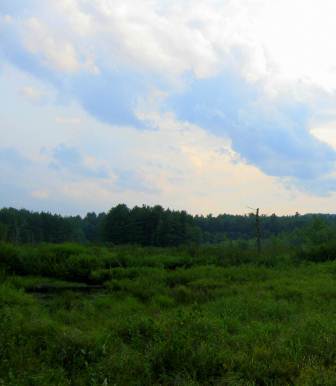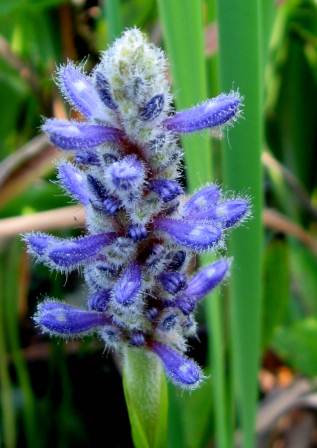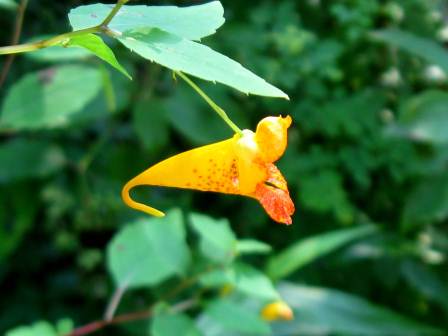Last Saturday I decided to see if the hobblebushes were in bloom, so I followed one of my favorite rail trails out into the forest to see them. It’s a six mile round trip along the Ashuelot River and there’s usually plenty to see, so I’ve been looking forward to it.
Before I had walked half a mile I saw coltsfoot (Tussilago farfara) growing in a ditch by the side of the trail and I was surprised that they were still blooming now, on this last day of April. In the past coltsfoot was thought to be good for the lungs and the dried leaves were often smoked as a remedy for asthma and coughs. It was also often used as a tobacco substitute, asthma or not. A native of Europe, it was most likely brought over by early settlers.
Coltsfoot leaves appear just as the flowers finish their brief display and there were plenty of leaves to be seen, so this is probably the last photo of a coltsfoot blossom to appear on this blog until next spring. It’s hard to say that; it seems like spring has barely gotten started.
We won’t have to go without yellow flowers though, even when the coltsfoot flowers fade. I don’t think I’ve ever seen as many dandelions (Taraxacum officinale) as we have this year. We should really grow (and eat) even more dandelions; I was just reading a paper by the University of Maryland Medical Center that said dandelions are “chock full of vitamins A, B, C, and D, as well as minerals such as iron, potassium, and zinc.” When I was a boy I ate the young spring leaves cooked just as spinach would have been. Like lettuce the leaves turn bitter with age, so you want to pick them young. I’ve also roasted and ground the roots to use as a coffee substitute, and it wasn’t bad.
Before long the rail trail crosses the Ashuelot River in Winchester. The old steel trestles still seem as strong as when they were built and are used by hikers, snowmobilers and bike riders. Other than snowmobiles in winter no motorized vehicles are allowed on rail trails, so it’s always a very peaceful hike.
The Ashuelot was calm here on this day, but it isn’t always so. Lack of runoff from snow melt has kept it at summer levels and it will be interesting to see how it looks in August, which is usually when it reaches its lowest levels in this area. In some places you can walk across it and barely get your ankles wet in high summer, but it would be wise know the place well before you try it.
Spring was busting out all over along the trail.
Ashuelot is a town named after the river, (I think) and this is their old railroad depot. There was once an upper Ashuelot (Keene) and lower Ashuelot (Swanzey) and Ashuelot streets and roads are still found today. The word Ashuelot is pronounced ash-wee-lot by out of towners or ash-wil-ot by locals. The pronunciation is most likely a corruption of the original Native American word, which meant “place between” in the Native Pennacook or Natick languages. Between what remains a mystery. Hills maybe; we have plenty of those and the river does run between them before finally joining the Connecticut River.
The town of Ashuelot also has a beautiful covered bridge built in 1864, which is a strange time because the Civil War was still raging. I’ve read that it was originally built so wood could be carried across the river to wood burning locomotives, but I have no way to verify that. Anyhow, in spite of the fighting it was built in two spans and is 160 feet long. It’s a Town lattice truss style bridge, patented by architect Ithiel Town in 1820. The open lattice work sides were a big step away from the solid walled bridges that came before it. Now, instead of being dark like a cave covered bridges were filled with light and had better air circulation. They also often had covered walkways for pedestrian traffic, as can be seen on this bridge. I’ve crossed both styles and the difference is amazing. The change must have been a very welcome one to people of the 1800s. At one time there were about 400 covered bridges in New Hampshire, and 70 of them were left at the end of the 20th century. The Ashuelot Bridge is listed on the National Register of Historic Places.
Violets blossomed in great profusion along the trail and made me wonder about all the beautiful things the railroad workers must have seen along these rail beds when the trains ran through here.
I didn’t bother trying to identify which violets they were. I just enjoyed them.
I didn’t have to try to identify the invasive garlic mustard (Alliaria petiolata) that grew in several places; I know it well. Garlic Mustard spreads quickly and prefers growing in shaded forests. It isn’t uncommon to find areas where no growing thing can be seen on the forest floor but this plant. It is considered one of the worst invasive species because of its ability to spread rapidly and is found in all but 14 U.S. states, including Alaska and large parts of Canada. It grows from 1-4 feet tall and has a strong but pleasant garlic / onion odor when the leaves are crushed. It’s really too bad that more restaurants don’t use this potherb, because people foraging for it might be a good way to control it.
Since it is native to North America it’s hard to describe the Canada mayflower (Maianthemum canadense) as invasive, but it does form monocultures much like garlic mustard and I’ve seen large swaths of forest floor with nothing but Canada mayflowers, as the above photo shows. Woe befalls the gardener who finds it in their garden, because its fibrous root system is almost impossible to eradicate once it has become established. If you try to pull the plant the leaf stem just beaks away from the root system and it lives on. The speckled red berries are eaten by ruffed grouse, white footed mice, and chipmunks, all of which help spread it throughout the forest.
I stopped here and took this photo because this is where a hawk circled over me, just above the treetops as I walked along. It didn’t make a sound but its shadow crossing in front of me gave it away and I didn’t even have to look up to know that it was escorting me down the trail. But of course I did look up and knew it was a hawk by the beautiful stripes on the underside of its tail feathers. Unfortunately many hawks seem to have like stripes, so I don’t know its name. I’ve had vultures circle me but never a hawk; for it to do so for a few minutes seemed like odd behavior and I wondered if I had stumbled into its nesting site.
While trying to find the identity of the hawk I read that some Native American tribes believed that a hawk showed itself to a person when the person needed to pay attention to the subtle messages found in the natural world around them. The hawk was also a messenger and was said to bring gifts that included clear sightedness, courage, wisdom, and illumination, the ability to see the bigger picture, creativity, truth, magic, and focus.
The Ashuelot gets very rocky in this area, mostly because of the low water level, and picking your way through in a canoe or kayak seems like it would be very tiring. If the rafts I built as a boy had done their job I would have had to face getting through it.
There are other obstacles to river travel as well. That’s a full grown white pine (Pinus strobus) that was stuck on the rocks. White pines are the largest trees in eastern North America, and often grow to 150 feet tall. In Colonial times they were said to grow to over 200 feet but later verifiable accounts measured them ae about 180 feet. It’s a tall tree in any event and seeing one lying in the river like that reminds you just how big this river can be.
There are places of bliss and torment in this world and we can usually tell which is which by the way we feel attracted to or repelled by them. This spot always calls to me when I hike here but when I took this photo I was about 30-40 feet above the river, and there is no good way down to it. It reminds me of an island in the river that I used to visit when I was a boy, and if I was 12 years old again I’d be spending a lot of my time down there in that little piece of Eden because if I couldn’t have found a path I’d have made one. Sometimes you have to put up with a little torment before you reach your place of bliss.
If you’ve ever lost yourself inside a painting, a poem, or a piece of music then you know why I’ll happily walk 6 miles to see a hobblebush (Viburnum lantanoides) in bloom. To see an entire riverbank full of them is beauty rare enough to see me walk twice as far. There really isn’t anything else quite like it in these spring woods, so you have to just stop and look.
I had to get a fallen tree off this example before I could take a photo because it had squashed most of the blossoming branches down to ground level, and as a thank you for freeing it the bush didn’t trip me up. The name hobblebush comes from the way the low growing branches, unseen under last year’s fallen leaves, can trip up or “hobble” a horse or hiker. The name is a good one; I’ve found myself sprawled on the forest floor beside it a few times. I was a little early in visiting them this time so some of the small fertile central flowers hadn’t fully opened, but the large outer sterile ones more than made up for it. If it wasn’t for the rail trail through here no one would ever see these beautiful shrubs or the wild azaleas and mountain laurels that will follow, and that would really be too bad.
Note: A viburnum with similar flowers called cranberry bush viburnum (Viburnum trilobum) can be found at nurseries.
Someone made a bench out of an old railroad tie. Normally there wouldn’t be anything noteworthy about that but this one is bent, and that’s very strange. It must be natural, maybe because of the weather; I don’t think mankind could find a way to bend one of these in that way unless steam was used. Surely it wasn’t done out here in the middle of the woods with only hand tools.
Man can do some remarkable things out in the woods with only hand tools though, and I wonder how many of these box culverts were built along these Boston and Maine Railroad tracks back in the mid-1800s. There must be thousands of them. This one caught my interest because every other one I’ve seen was put up dry with no mortar, but this one had all its joints mortared. I’m guessing it was a repair that came later. You can see how the bottom left corner of the opening is kicked in towards the center a bit and instead of repairing it correctly someone must have tried to cement it back together. How the damage could have happened in the first place I don’t know, but since I usually have a pocket full of mysteries when I leave places like this, adding one more was no real burden.
Forget me nots asked that I remember all I had seen here today. I’m fairly certain that it’ll stay with me for quite a while.
Life is full of beauty. Notice it. Notice the bumble bee, the small child, and the smiling faces. Smell the rain, and feel the wind. Live your life to the fullest potential, and fight for your dreams. ~Ashley Smith
Thanks for coming by.












































































 I’ve had a hard time getting close to this floating bladderwort (Utricularia radiate) but finally, after 2 months, I got close enough to get a decent photo and its flower was closed! Oh well-you’ll have to trust me when I say that the small yellow, snapdragon-like flower is unusual and beautiful. What I really wanted to point out about the plant are the unusual leaf stalks (petioles) that have evolved into floats. In the fall the plant forms what are called winter buds on its underwater stems. These buds and bits of stem are all that survive the winter on the pond bottom. In spring when the water warms they inflate and float to the surface where they start to grow into new plants. These plants float in ponds and slow moving streams and trap insects in underwater bladders.
I’ve had a hard time getting close to this floating bladderwort (Utricularia radiate) but finally, after 2 months, I got close enough to get a decent photo and its flower was closed! Oh well-you’ll have to trust me when I say that the small yellow, snapdragon-like flower is unusual and beautiful. What I really wanted to point out about the plant are the unusual leaf stalks (petioles) that have evolved into floats. In the fall the plant forms what are called winter buds on its underwater stems. These buds and bits of stem are all that survive the winter on the pond bottom. In spring when the water warms they inflate and float to the surface where they start to grow into new plants. These plants float in ponds and slow moving streams and trap insects in underwater bladders. I found this forget-me-not (Myosotis scorpioides) growing on a river bank. Books tell me that the plant grows naturally on the banks of streams and rivers, but this is the only time I’ve ever seen one there in spite of spending over 50 years exploring such places. There are over 50 species of forget-me-nots; some are native to North America and some are European natives.
I found this forget-me-not (Myosotis scorpioides) growing on a river bank. Books tell me that the plant grows naturally on the banks of streams and rivers, but this is the only time I’ve ever seen one there in spite of spending over 50 years exploring such places. There are over 50 species of forget-me-nots; some are native to North America and some are European natives.


 At first I thought this plant was northern bugleweed (Lycopus uniflorus) but I can’t find any reference to reddish leaves and dark purple stems for that plant. Instead, it must be the very similar looking taper leaf water horehound (Lycopus rubellus.) Its description includes both reddish leaves and stems which can be more purple than green, especially when it grows in bright light. Both plants love wet soil and are good wetland indicators. I found this one growing in full sun on a riverbank in a place that is often covered by water. I’ve seen it countless times but have really never paid it any attention.
At first I thought this plant was northern bugleweed (Lycopus uniflorus) but I can’t find any reference to reddish leaves and dark purple stems for that plant. Instead, it must be the very similar looking taper leaf water horehound (Lycopus rubellus.) Its description includes both reddish leaves and stems which can be more purple than green, especially when it grows in bright light. Both plants love wet soil and are good wetland indicators. I found this one growing in full sun on a riverbank in a place that is often covered by water. I’ve seen it countless times but have really never paid it any attention.
